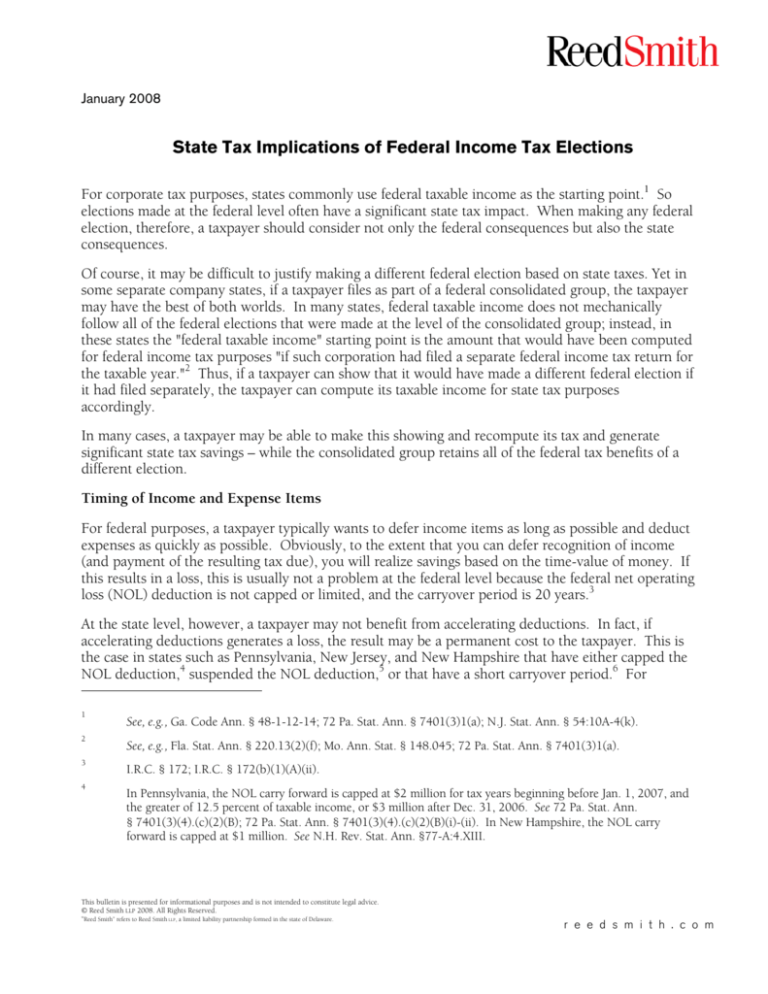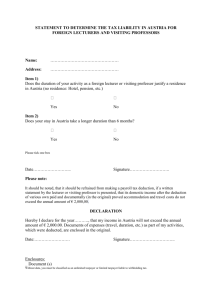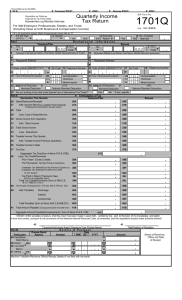
January 2008
State Tax Implications of Federal Income Tax Elections
For corporate tax purposes, states commonly use federal taxable income as the starting point.1 So
elections made at the federal level often have a significant state tax impact. When making any federal
election, therefore, a taxpayer should consider not only the federal consequences but also the state
consequences.
Of course, it may be difficult to justify making a different federal election based on state taxes. Yet in
some separate company states, if a taxpayer files as part of a federal consolidated group, the taxpayer
may have the best of both worlds. In many states, federal taxable income does not mechanically
follow all of the federal elections that were made at the level of the consolidated group; instead, in
these states the "federal taxable income" starting point is the amount that would have been computed
for federal income tax purposes "if such corporation had filed a separate federal income tax return for
the taxable year."2 Thus, if a taxpayer can show that it would have made a different federal election if
it had filed separately, the taxpayer can compute its taxable income for state tax purposes
accordingly.
In many cases, a taxpayer may be able to make this showing and recompute its tax and generate
significant state tax savings – while the consolidated group retains all of the federal tax benefits of a
different election.
Timing of Income and Expense Items
For federal purposes, a taxpayer typically wants to defer income items as long as possible and deduct
expenses as quickly as possible. Obviously, to the extent that you can defer recognition of income
(and payment of the resulting tax due), you will realize savings based on the time-value of money. If
this results in a loss, this is usually not a problem at the federal level because the federal net operating
loss (NOL) deduction is not capped or limited, and the carryover period is 20 years.3
At the state level, however, a taxpayer may not benefit from accelerating deductions. In fact, if
accelerating deductions generates a loss, the result may be a permanent cost to the taxpayer. This is
the case in states such as Pennsylvania, New Jersey, and New Hampshire that have either capped the
NOL deduction,4 suspended the NOL deduction,5 or that have a short carryover period.6 For
1
See, e.g., Ga. Code Ann. § 48-1-12-14; 72 Pa. Stat. Ann. § 7401(3)1(a); N.J. Stat. Ann. § 54:10A-4(k).
2
See, e.g., Fla. Stat. Ann. § 220.13(2)(f); Mo. Ann. Stat. § 148.045; 72 Pa. Stat. Ann. § 7401(3)1(a).
3
4
I.R.C. § 172; I.R.C. § 172(b)(1)(A)(ii).
In Pennsylvania, the NOL carry forward is capped at $2 million for tax years beginning before Jan. 1, 2007, and
the greater of 12.5 percent of taxable income, or $3 million after Dec. 31, 2006. See 72 Pa. Stat. Ann.
§ 7401(3)(4).(c)(2)(B); 72 Pa. Stat. Ann. § 7401(3)(4).(c)(2)(B)(i)-(ii). In New Hampshire, the NOL carry
forward is capped at $1 million. See N.H. Rev. Stat. Ann. §77-A:4.XIII.
This bulletin is presented for informational purposes and is not intended to constitute legal advice.
© Reed Smith LLP 2008. All Rights Reserved.
“Reed Smith” refers to Reed Smith LLP, a limited liability partnership formed in the state of Delaware.
r e e d s m i t h . c o m
instance, New Jersey's seven-year net operating loss carryover period creates an incentive for a
taxpayer that is generating significant losses to "push" its NOLs out over a longer period of time so
that they don't expire. This is especially important for start-up companies and taxpayers engaged in
high-tech or biotechnology businesses. These types of companies often have significant costs (and
thus losses) early on, and may not recoup these costs for many years. By then, the NOLs may have
already expired.
Therefore, to avoid losing the benefit of NOLs in certain states, it may make sense to more closely
match expenses and income by deferring deductions. To do this, a taxpayer should consider, in
computing its pro forma separate company federal taxable income, taking advantage of federal
elections that the taxpayer would have made "if such corporation had filed a separate federal income
tax return for the taxable year."
The Election Under I.R.C. § 59(e) to Amortize Research Expenses
The default rule is that research or experimental expenditures are deductible as current expenses in
the tax year they accrue.7 But an election is available under I.R.C. § 59(e) that allows a taxpayer to
deduct these expenses ratably over a 10-year period, beginning with the taxable year in which such
expenditure is made.
The practical application of I.R.C. § 59(e) is that a company that would otherwise take the total
amount of the expenditure as a deduction in the year it was incurred may instead spread the
deduction out over a 10-year period. As noted above, this may be particularly attractive to a taxpayer
with significant apportionment in a state with a significant NOL limitation, such as a short carryover
period.
For instance, consider a start-up pharmaceutical company subject to tax in a state with a short NOL
carryover period. It is likely that the company will experience losses for several years while research,
development, and clinical trials are performed in advance of FDA approval. In such a situation, the
company may want to compute its pro forma federal taxable income as if it had made a federal
election under § 59(e) to spread out its deductions. This will prevent NOLs from expiring and
enable the taxpayer to offset its future income with the deductions that generated that income. The
separate taxpayer may make this election even though, on the consolidated return, the group has
deducted the expense in full when incurred because, at the group level, there was other income that
could be offset by the deduction.
Importantly, the 59(e) election can be made for any portion of a qualified expenditure.8 In other
words, it is not an all-or-nothing election. This gives a taxpayer more flexibility to match its
expenses and income.
5
6
7
8
From tax years 2002 through 2003, the net operating loss deduction was suspended in New Jersey, and from
2004 through 2005, the deduction was limited to 50 percent of net income. See N.J. Stat. Ann. § 54:104(k)(6)(D)
– (E).
In general, New Jersey only allows a seven-year net operating loss carryover. See N.J. Stat. Ann. § 54:10A4(k)(6)(A).
I.R.C. § 174(a).
I.R.C. § 59(e)(4)(A).
-2-
Using Straight-line Depreciation Instead of Bonus Depreciation
A taxpayer may also want to consider taking advantage of the Code's choice of depreciation methods.
Under I.R.C. § 41, a taxpayer may use accelerated or straight-line depreciation methods. Once again,
for a taxpayer in a state with a significant NOL limitation, the taxpayer may not want to use an
accelerated method; rather, it may prefer to use straight-line depreciation that will spread the
deduction. Again, this method may be used by the taxpayer on a separate state basis even though the
accelerated method is used by the consolidated group at the federal level, so long as the taxpayer
could argue that it would have used the method if it had "filed a separate federal income tax return
for the taxable year." Often the best way to show this is to show that a consolidated group could take
advantage of the accelerated deduction because some other member of the group had income, even
though, on a separate company basis, the deduction merely exaggerated a loss.
Choosing Between a Credit Versus a Full Deduction for Qualified Research Expenses
Federal law provides a credit for increasing research and experimentation expenditures.9 A
20 percent credit is allowed to the extent qualifying expenditures in the taxable year exceed a "base
amount." (This base amount is computed by reference to qualifying expenditures in prior years.) A
taxpayer can take all of that credit, but must forgo deductions to the extent of the credit.10
Alternatively, a taxpayer can take 65 percent of the credit and take the full deduction.11 A corporate
taxpayer in the highest marginal federal income tax bracket is often indifferent between those two
options because the resulting federal tax liability is identical.12 Often, the decision between the two
methods hinges on the computation of the federal credit for foreign taxes.
Obviously, if state taxes were the only consideration, a taxpayer would want to forgo the credit and
take the full deduction for research and experimentation expenditures. States that use federal taxable
income as a starting point typically begin with line 28 taxable income,13 which doesn't reflect federal
credits.14 Therefore, if a taxpayer can demonstrate that it would have taken the reduced research
credit if it had filed separately (or at least wouldn't pay more federal tax on a separate basis by taking
the reduced credit), it should be able to compute its pro forma separate company federal taxable
income (and thus its state taxable income) by taking the full deduction for research and
experimentation expenses. To do so, a taxpayer often can show that, on a separate company basis, it
would not have had foreign tax credits, so for purposes of separate company federal taxable income,
it would have been indifferent between the methods. This separate taxpayer, therefore, would have
elected to take the full deduction and the reduced credit because that method would have resulted in
less state tax, with no impact on its federal tax.
9
10
11
12
13
14
I.R.C. § 41.
I.R.C. § 280C(c)(1).
I.R.C. § 280C(c)(3).
Not all taxpayers, even ones in the highest tax bracket are indifferent, however. For example, taking the reduced
credit and the full deduction for research and experimentation expenses can reduce a taxpayer’s foreign tax
credit. See I.R.C. § 904.
See, e.g., 72 Pa. Code 153.11(a); N.J. Stat. Ann. § 54:10A-4(k);
See Federal IRS Form 1120.
-3-
Conclusion
An election made by a federal consolidated group is often not binding on the computation of "federal
taxable income" in separate company states. In many states, the statute requires that a taxpayer
determine the amount of federal taxable income it would have computed if it had computed its tax
separately. The result may better match income with expenses, and otherwise resuscitate lost
deductions.
*
*
*
*
*
*
Reed Smith is a top-15 global relationship law firm with more than 1,600 lawyers in 23 offices
throughout the United States, the United Kingdom, Europe, the Middle East and Asia. Founded in
1877, the firm represents leading international businesses from Fortune 100 corporations to midmarket and emerging enterprises. Its attorneys provide litigation services in multi-jurisdictional
matters and other high stake disputes, deliver regulatory counsel, and execute the full range of
strategic domestic and cross-border transactions. Reed Smith is a preeminent advisor to industries
including financial services, life sciences, health care, advertising and media, shipping, international
trade and commodities, real estate, manufacturing and education. For more information, visit
reedsmith.com.
-4-






